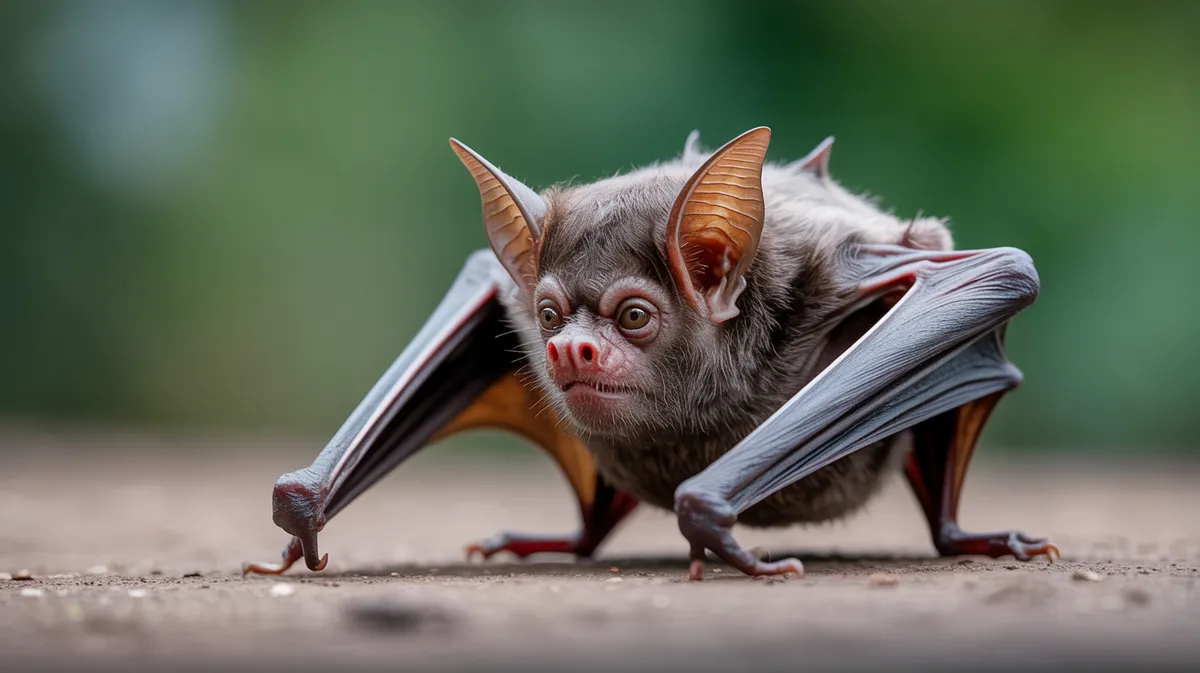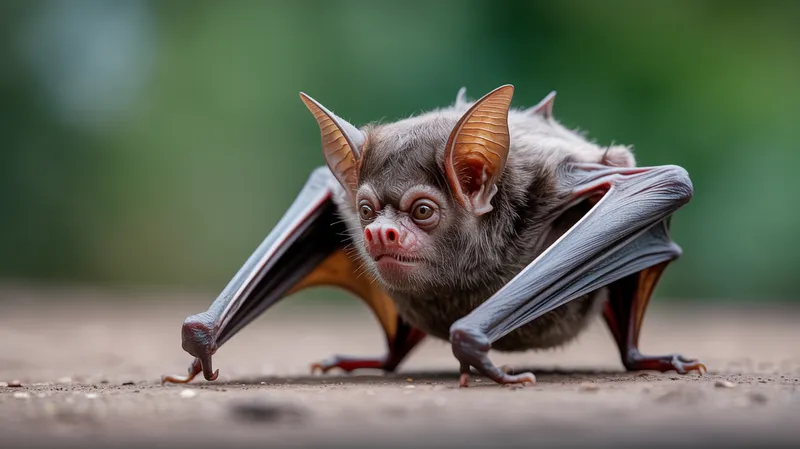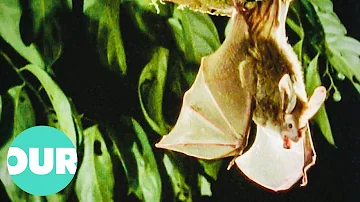
Vampire Bat
Desmodus rotundus

Meet the Vampire Bat
The vampire bat is a small, nocturnal mammal famous for its unique feeding strategy: drinking the blood of other animals. Native to Central and South America, vampire bats have specialized adaptations, such as heat sensors on their nose and razor-sharp teeth, allowing them to locate and access blood vessels. Unlike most bats, they are agile on the ground and can walk, hop, and leap towards their prey. Vampire bats live in colonies and exhibit social behaviors like food sharing among roost-mates.
Classification
Mammal
Habitat
Tropical and subtropical forests, grasslands, and savannas
Diet
Carnivore (Obligate Hematophagy)
Lifespan
9-12 years in the wild
Conservation
Least Concern
Weight
19-57 grams
📖Fascinating Facts
Blood Diet
Vampire bats feed solely on blood, mainly from livestock, using specialized heat sensors to locate blood vessels under the skin.
Ground Mobility
Unlike most bats, vampire bats are adept at walking, hopping, and even leaping on the ground to approach their prey.
Medical Research
The anticoagulant properties in vampire bat saliva have inspired new treatments for stroke and heart attack patients.
📋Detailed Description
The common vampire bat (Desmodus rotundus) is a small, robust bat with a forearm length of 57–66 mm and a body mass typically ranging from 27 to 40 grams. Its fur is short and velvety, colored grayish-brown dorsally and paler ventrally. The face is characterized by a leaf-shaped nose and prominent thermoreceptors that aid in detecting blood-rich areas on prey. Unlike most bats, Desmodus rotundus possesses strong, elongated thumbs and specialized hind limbs, enabling agile terrestrial locomotion; it can walk, hop, and even leap with remarkable dexterity. The dental formula is highly specialized, with razor-sharp upper incisors and canines for slicing skin, and reduced molars reflecting its liquid diet. Socially, vampire bats form stable colonies ranging from a few individuals to over a hundred, often roosting in hollow trees, caves, or abandoned buildings. These colonies are structured around complex social bonds, with frequent grooming and reciprocal food sharing, particularly among females. Their unique feeding strategy involves making a small incision in the skin of a sleeping mammal (often livestock), then lapping up the blood with a grooved tongue; anticoagulant compounds in their saliva prevent clotting. Vampire bats are nocturnal, emerging at night to feed, and returning to their roosts before dawn. Their reproductive cycle is non-seasonal in much of their range, and females typically give birth to a single pup after a gestation period of about 205–214 days.
💡 Did you know?
Vampire bats are the only mammals that feed exclusively on blood.
🔬Research & Sources
Wikipedia Summary
Vampire bats, members of the subfamily Desmodontinae, are leaf-nosed bats currently found in Central and South America. Their food source is the blood of other animals, a dietary trait called hematophagy. Three extant bat species feed solely on blood: the common vampire bat, the hairy-legged vampire bat, and the white-winged vampire bat. Two extinct species of the genus Desmodus have been found in North America.
Last Modified: 6/3/2025
🎭Behavior & Social Structure
Vampire bats exhibit highly coordinated nocturnal foraging behavior, typically leaving the roost in small groups shortly after dusk. They rely on a combination of echolocation, olfaction, and infrared thermoreception to locate suitable hosts. Upon finding a host, they approach stealthily on the ground, using their agile limbs to move undetected. Feeding lasts 20–30 minutes, during which the bat makes a small, painless incision and laps up 15–20 mL of blood. Social interactions within colonies are sophisticated; food sharing is common, particularly among related females and frequent roost-mates, and involves regurgitation of ingested blood to individuals that failed to feed. Grooming is another key social behavior, reinforcing bonds and reducing parasite loads. Daily routines include periods of rest, grooming, and social interaction during daylight hours, with foraging and feeding occurring at night.
👶Reproduction & Life Cycle
Desmodus rotundus displays a polygynous mating system, with dominant males defending territories within the roost that attract females. Breeding occurs year-round in tropical environments, though some populations may show seasonal peaks. Females give birth to a single offspring after a gestation of approximately 7 months (205–214 days). Pups are born altricial, weighing about 5–7 grams, and are carried by the mother for the first week. Lactation lasts for about 3–4 months, after which juveniles begin to accompany mothers on foraging trips and gradually transition to independent feeding. Maternal care is extensive, with mothers and close kin providing food to young bats through regurgitation. Sexual maturity is typically reached at 9–10 months for females and slightly later for males.
🛡️Adaptations & Survival
Vampire bats possess a suite of remarkable adaptations for hematophagy. Their snout is equipped with specialized heat-sensing pits that detect blood vessels beneath the skin of their prey. The upper incisors are exceptionally sharp and lack enamel, allowing them to make clean incisions. Their saliva contains a complex cocktail of anticoagulants, vasodilators, and anesthetics, notably the enzyme 'draculin,' which inhibits blood clotting. The tongue is grooved for efficient lapping of blood. Their kidneys are adapted for rapid excretion of excess plasma, enabling them to fly after consuming a large liquid meal. Behaviorally, their advanced social structure and reciprocal feeding reduce starvation risk. Terrestrial locomotion is highly developed, with strong limbs and musculature allowing for walking, hopping, and even short leaps.
📚Research Sources
🎨Cultural Significance
Vampire bats have a prominent place in folklore and mythology throughout the Americas, often associated with darkness, death, and supernatural powers. Their unique feeding habits contributed to the European vampire legend after the discovery of the Americas. In indigenous cultures, they are sometimes viewed as omens or symbols of transformation. In modern times, they are both feared for their role in disease transmission and studied for the medical potential of their anticoagulant saliva, which has inspired research into novel treatments for blood clotting disorders.
🔬Recent Research & Discoveries
Recent research has focused on the molecular composition of vampire bat saliva, leading to the identification of 'draculin' and other bioactive compounds with potential pharmaceutical applications. Studies using stable isotope analysis have revealed dietary preferences and foraging ranges. Social network analyses have elucidated the mechanisms of reciprocal food sharing and cooperation. Genomic studies have uncovered adaptations related to immune function, metabolism, and sensory perception. Ongoing research is examining the impact of climate change on range expansion and the epidemiology of rabies transmission in livestock and humans.
🎥Wildlife Videos

Vampire Bats | World's Weirdest
#NatGeoWILD #WorldsWeirdest #Bats About World's Weirdest: A buffalo with three eyes, an exterminator who eats his day's work, ...
Nat Geo Animals

The Rarely Seen Nightlife Of Bats & Why They Are Vital For The Earth | Our World
This film looks at why these creatures will play a vital role in mankind's future existence on Earth. This film was first broadcast: 05 ...
Our World

How Vampire Bats Suck Blood for 30 Minutes Unnoticed
Thanks to a local anesthetic in their spit, vampire bats are able to drink blood from their prey without being detected. That way ...
Smithsonian Channel

Wild America | S4 E1 Beneficial Bats | Full Episode HD
Long the misunderstood subject of myth and legend, Bats are hardly a favorite form of wildlife. Yet they are among our most ...
Wild America Animal Channel

Secrets and Mysteries of Bats - Nature Documentary
Secrets and Mysteries of Bats - Nature Documentary This 48-minute documentary explores the world of bats and the scientists ...
John Wall

Vampire Bats | World's Deadliest
#NatGeoWILD #Bats #WorldsDeadliest About World's Deadliest: World's Deadliest Predators is a new series that looks at most ...
Nat Geo Animals
🌍Habitat Information
The Vampire Bat typically inhabits Tropical and subtropical forests, grasslands, and savannas environments. Vampire Bats have adapted to their environments with specialized features and behaviors.
Primary Habitat:
Tropical and subtropical forests, grasslands, and savannas
More detailed habitat information will be available soon.
🛡️Conservation Status
The Vampire Bat is currently classified as Least Concern. Conservation efforts are crucial for preserving this species for future generations.
Common Threats:
- 🏠Habitat loss and fragmentation
- 🌡️Climate change impacts
- 🎯Hunting and poaching
- 🏭Human-wildlife conflict
⚠️Threats & Conservation Challenges
While currently listed as Least Concern by the IUCN, vampire bats face several threats, primarily from habitat loss due to deforestation and agricultural expansion. Culling campaigns aimed at controlling rabies transmission have led to local population declines. The use of anticoagulant poisons and destruction of roosts can have unintended ecological consequences. Climate change may alter the distribution of both bats and their prey, potentially expanding their range. Human-wildlife conflict arises from their association with livestock predation and disease transmission, particularly rabies, which can result in negative perceptions and persecution.
🔬Scientific Classification
Scientific Name
Desmodus rotundus
Classification Hierarchy
🔍 About Taxonomic Classification
Taxonomic classification is a hierarchical system used by scientists to classify and organize living organisms based on shared characteristics and evolutionary relationships.
The system moves from broad categories (Kingdom) to increasingly specific ones, with each animal's scientific name typically consisting of its Genus and species.
📝Community Notes
Share your observations and insights about the Vampire Bat with our community of wildlife enthusiasts.
Join Our Community
Sign in to share your observations and connect with fellow wildlife enthusiasts.
Sign In to ContributeNo community notes yet
Be the first to share your observations about the Vampire Bat!
Explore Vampire Bat
Select a tab above to learn more about this amazing animal.
📸Photo Gallery
No photos available for this animal yet.
🌟Discover More Wildlife
Continue your journey of discovery with more fascinating animals from our database
